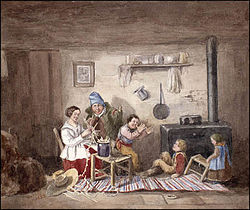

Habitants (French: [abitɑ̃]) were French settlers and inhabitants of French origin who farmed the land along both shores of the St. Lawrence River and the Gulf of St. Lawrence in what is now Quebec, Canada. The term was used by the inhabitants themselves and the other classes of French Canadian society from the 17th century to the early 20th century, when the word declined in usage in favour of the more modern agriculteur (farmer) or producteur agricole (agricultural producer).
Habitants in New France were largely defined by the condition on the land that it could be forfeited unless it was cleared within a certain period of time.[1] That condition kept the land from being sold by the seigneur and led instead to its being subgranted to peasant farmers, also called habitants.[1] When habitants were granted the title deed to a lot, they had to agree to accept a variety of annual charges and restrictions. Rent was the most important of them and could be in money, produce, or labour. Once the rent was set, it could not be altered for inflation or time.[2] Habitants essentially free to develop their land as they wished, with only a few obligations to the seigneur.
Likewise, a seigneur did not have many responsibilities towards his habitants. The seigneur was obligated to build a gristmill for his tenants, who in turn were required to grind their grain there and to provide him with one sack of flour out of every 14. The seigneur was also allowed to a specific number of days of labour by habitants and to claim rights over fishing, timberm, and common pastures.[3]
Though the seigneurs' demands became more significant at the end of French rule, they could neither obtain enough resources from the rents and fees imposed on the habitants alone to become truly wealthy or to leave their tenants in poverty.[4] Habitants were free individuals; seigneurs simply owned a "bundle of specific and limited rights over productive activity within that territory". The seigneur–habitant relationship was one in which both parties were owners of the land and divided the attributes of ownership between them.[5]
- ^ a b Coleman 1937, p. 134
- ^ Greer 1997, p. 37
- ^ Greer 1997, p. 38
- ^ Greer 1997, p. 39
- ^ Greer 1997, p. 40